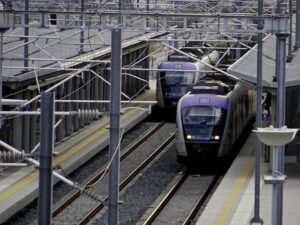A railway accident was avoided at the last moment this morning, just outside Athens, with a near collision between two trains which due to a wrong order risked being on the same single line running in opposite directions.
Specifically, according to the information, the telecommand of the Acharnon Railway Centre allowed both trains to move in opposite directions at a speed of 60 km/h, and almost on a single line, i.e. on a collision course. While the first train, number 1210, had received permission and a signal from the Athens stationmaster to proceed to Agioi Anargyros, the engineer observed from the conversations that the second train, number 1307, coming from Kiato to Athens, was also ordered to start at that time.
Almost at the same time, the driver of train 1307 sensed the situation and stopped the train, immediately, as soon as it had left the SS Agion Anargyroi and at a distance of 500 m before it entered the single line.
The incident occurred at 09:13 and is attributed to an error by the OSE traffic controller at SKA, who thought that one train, 1210, coming from Athens to the Airport had already passed through the single-track section and gave an order to the other, 1307 coming from Kiato, to“pass freely.”
After the OSE management was informed about the incident, the following actions were taken, according to the OSE statement :
* An investigation was ordered to ascertain the circumstances of the incident.
* The station master of the SKA who gave the order for the departure of 1307 was suspended and referred to the Disciplinary Committee.
* The material of the GSM-R and VHF sound recordings was collected.
* RAS and EODASAM were informed about the incident.
As OSE said in a statement, “It is stressed once again that, the strict adherence to the provisions of the General Traffic Regulation by all parties involved in the movement of trains, which includes multiple safety safeguards, is the decisive factor in the smooth conduct of rail traffic. The OSE Management has taken initiatives to further enhance the training of staff in order to prevent individual errors. The aim remains the continuous improvement of services, with the safety and confidence of passengers as the top priority.”
Ask me anything
Explore related questions





